The unmistakable chill of early winter – far more than a mild nip, but less severe than the harsh bite that comes later in the season – settled on our town mere days after Samhain.
A dusting of snow, like the most ethereal of glitter, elegantly wafted to the ground. It did not stick around for long, but its presence let all and sundry know that fall’s death knell had rung out across the land.
By mid-November, multiple inches were accumulating. For a while a few gentle reminders of autumn managed to hang on a wee bit longer. True to form for this area (and much of the country, for that matter) though, winter had in fact arrived more than a month before its official start date.
In the Western Hemisphere, that date (the Winter Solstice) falls on Wednesday December 21st this year.
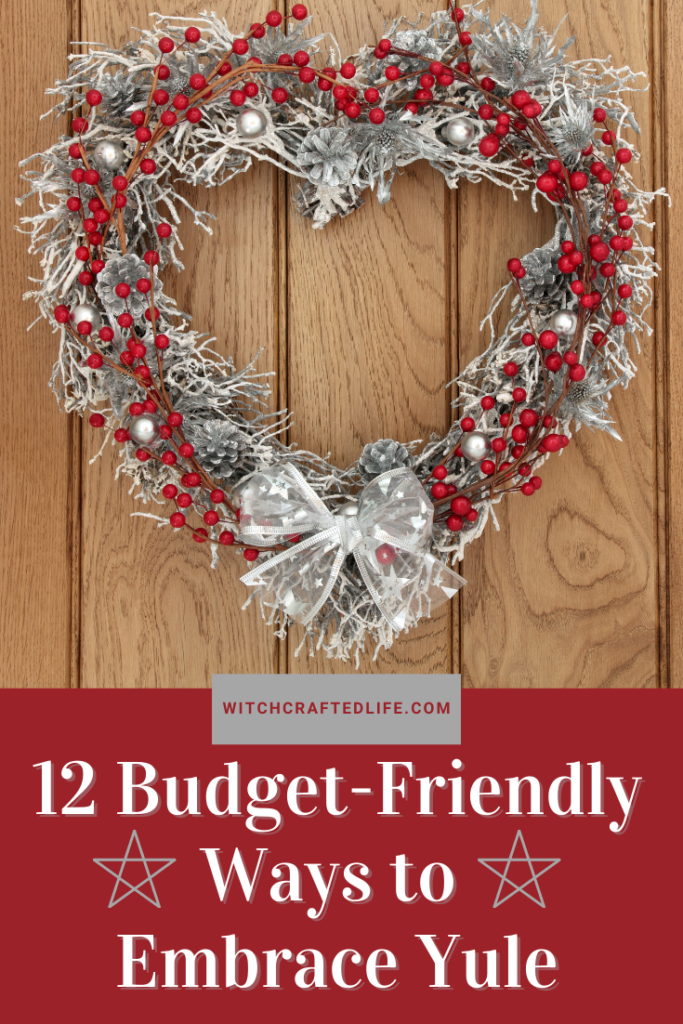
The Winter Solstice houses the shortest day and longest night of the entire year (these two appear in the reverse order on the Summer Solstice).
For many who opt to follow the Wheel of the Year, the Winter Solstice ushers in not only the beginning of winter itself, but also the Pagan sabbat of Yule.
I would venture to say that, particularly in contemporary times, no other sabbat is more familiar to the broader public sphere than that of Yule.
The words “Yule” and “Yuletide” are to this day still often used somewhat interchangeably with “the holiday season” and “Christmas” – as well as being another name for the Winter Solstice itself.
Case in point, we hear Yule sung about in numerous Christmas songs.
For example, “We Wish You a Merry Christmas”, in which appears the line, “We wish you the merriest, the merriest, the merriest Yule cheer.”
There is also “Cool Yule” (Louis Armstrong’s version is my personal fave), Deck the Halls (with its classic line, “troll the ancient yuletide carol”), and Cool Yule, to name but three more.
Last year we got in the festive Yule spirit – and put our craft rooms to especially good use – with a roundup of 50 Awesome DIY Yule Decorations and Craft Ideas You Can Make For the Winter Solstice.
This time around, I thought it would be a great idea to help celebrate Yule by putting it at the heart of the latest edition in Witchcrafted Life’s Free and Low-Cost Ways to Celebrate the Pagan sabbats series.
If you are new to this series or haven’t had a chance to check out the other entries that have appeared as part of it so far, you can do so via the following three links.
–10 Free and Low-Cost Ways to Celebrate Imbolc (post written for the site The Witch of Lupine Hollow, when I was a content contributor there)
–10 Free and Low-Cost Ways to Celebrate Ostara
–15 Free and Low-Cost Ways to Celebrate Mabon
Before we hop straight into our meaningful selection of 12 Free and Low-Cost Ways to Celebrate Yule and the Winter Holiday Season, let’s take a moment to explore the history and significance of Yule itself.
A brief history of Yule
There is something cozy and beautifully timeless about the word Yule. Just as there is regarding the thoughts, memories, and imagery that Yule conjures up for many of people.
Yule does not have as many alternative names as some of the other Pagan sabbats that comprise The Wheel of the Year. That said, it is also known in English by such titles as Yulefest, Yuletide, Yule Time, and Yule Season.
The word Yule itself is a modern take on a handful of similar Old English words, including ġēol (which covered the traditional 12-day festival of Yule) and ġēoli, which indicated the month of Yule.
These words are thought to have even older etymological roots that stretch back to languages such as Old German, Old Norse, Icelandic, Norwegian, and Faroese, as well, possibly, as Old French.
Interestingly, the pedigree of the word Yule is not completely agreed upon and remains a point of interest and friendly debate amongst scholars and linguists alike.
The festival of Yule or the broader season of Yuletide is one that was historically observed by the Germanic peoples, including the Norse.
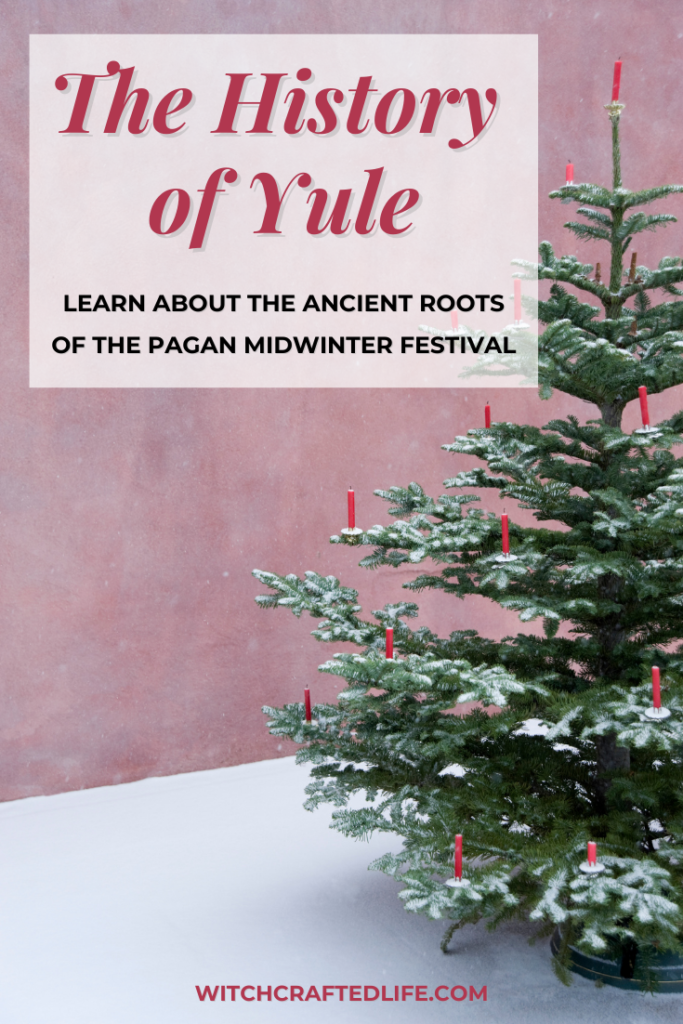
Yule is thought to trace its roots back to the concept of The Wild Hunt and to the powerful Norse god named Odin.
This god was, and still is for some, known by many different names, including Jólnir. This name translates to “the Yule one” in English.
As well, some of Yule’s roots are most likely planted in the Anglo-Saxon Pagan celebration known as Modranicht (an Old English word that translates to “Night of the Mother’s or “Mother’s Night”). This annual December event was held on or around December 24th, the day we now assign to Christmas Eve.
Traditionally, Yule was an indigenous winter festival that was observed by a wide range of Germanic peoples. Early Yule celebrations transpired between mid-November and early January.
Even though Yule was subjected to Christianization, which attempted to sway it away from its Pagan roots, many older traditions refused to die out.
Some were revamped, but others appear to have remained fairly true to their pre-Christian origins. For example, the burning of Yule logs, as well as classic Yule goats and Yule boars, plus Yuletime singing.
Written records pertaining to Yule are known to exist dating back to at least the 4th century CE.
Yule is also discussed in some of the classic Norse Sagas, including the Saga of Hakon the Good (in which is it stated that Yule was traditionally celebrated for three nights from Midwinter – aka, the Winter Solstice – onward).
As with a great deal of the past, the precise origins and elements that comprised early Yule celebrations may never be known in their entirety these days.
What is broadly accepted, however, is that Yule celebrations likely centered on the general time period of Midwinter (again, the Winter Solstice), included feasting and drinking, marked the return of days that would once again start to grow longer, and may have involved various forms of religious activities, such as sacrifice and ancestor veneration – plus that ongoingly popular and beloved classic, the Yule log.
As with the Summer Solstice and both the Spring and Fall Equinoxes, Winter Solstice celebrations were by no means confined to those of Central and Northern Europe.
Early peoples from around the world had long celebrated, honoured, and rejoiced in the shifting of the seasons, as well as the tilting of the earth’s axis that brings about the return of (literal) brighter days.
For example, the ancient Egyptians honoured the return of their sun god, Ra, in December and the same month would play host to the ancient Roman’s well-known celebration of Saturnalia. This revelry and merriment-filled event, which began around December 17th, lasted for a week and honoured the god Saturn.
The name Midwinter itself is quite interesting, as – just as with Litha/the Summer Solstice’s alternative name, Midsummer – it speaks of a calendar and rhythm to the seasons that is not per se in direct keeping with our current mainstream versions.
Instead, the word Midwinter tells us at that for certain earlier communities, the third week of December (or the general Yule period itself) was not seen as the start of winter, but rather its midway point.
Some people still strive to live in step with these earlier seasonal lines, which add more weight to Imbolc (at the start of February) being viewed as the unofficial start of spring.
This short overview of the history of Yule barely scratches the holly and ivy-covered surface of this ancient wintertime festival. I hope, however, that you found it informative and interesting all the same. 😃
If you are keen to learn more about the history, customs, folklore, and traditions of Yule, I highly suggest checking out the entries listed in my post Your Ultimate Guide to Books About the Pagan Sabbats. This roundup includes numerous titles that either focus solely on Yule or contain a wealth of knowledge about Midwinter.
Some themes and meanings of Yule
For both the ancients and many individuals to this day, Yule is a time to celebrate light and life.
The second half of December might not win any awards for the sunniest or warmest half of the year (north of the equator), but the Winter Solstice does mark the return of longer minutes of precious daily sunlight and that is well worth celebrating. 🥳
Hearty, resilient plants such as evergreens, birch, yew, oak, holly, ivy, and mistletoe (many of which have strong connections to the Celts of yore) help us to feel all the more connected to Mother Nature as darkness and frigid temperatures envelop our world.
These plants are amongst those that often manage to hold on and keep growing – or at least not wither and die off for the season entirely – during late fall and early winter. The depth of their verdant hues coupled with their festive connotations make them beloved classics for Pagans/witches and non-Pagans/witches alike.
Honouring light and welcoming longer days (even if we have to wait several more weeks still to really get a sense of this shift towards lengthier periods of daily sunlight) is an integral part of many peoples’ Yule celebration.
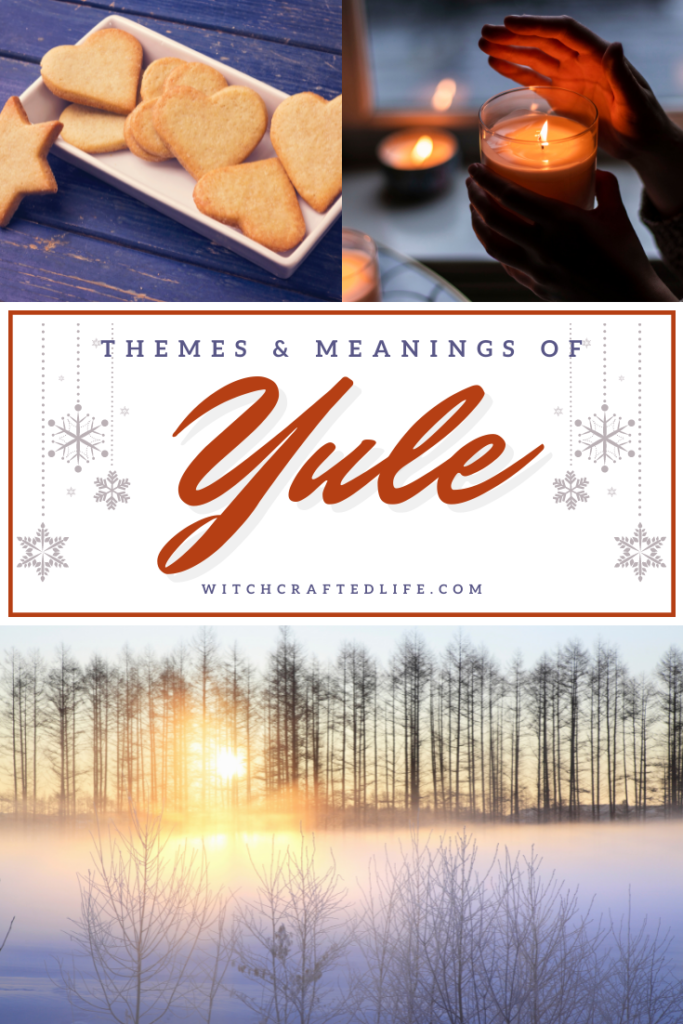
Candles, artificial light sources, and warming fires can all help to honour the sun and the invaluable role it has in sustaining life on this planet.
In much the same vein, we warm our bellies and spirits alike by turning to comforting, hearty foods during Yuletide.
Beloved favourites such as cinnamon, nutmeg, ginger, cloves, allspice, cardamon, citrus fruits, baked goods of all kinds, root vegetables, a wide array of roasted dishes, sweets, punches, wine, ale, and eggnog are just some of the classic foods that are frequently enjoyed during Yule.
Just as they are for many during the Christmas and New Year season.
For those who follow certain Neopaganism traditions/paths, the archetypical legend of the age-old battle between the Oak King and the Holly King (each of whom is viewed in some traditions as being duel aspects of the male Horned God) is another cornerstone of Yule time celebrations.
Come Midwinter, the Oak King once again bests the Holly King and takes his rightful place on the throne from Yule until Litha/Midsummer. When, at that time, the two duke it out once more. Only that time around, it is the Holly King that comes out victorious for the summer and autumn-filled half of the year.
However, some belief systems see the two winners reversed, thus the Holly King rule supreme from the Winter Solstice onward to Litha.
Either way, these legends/beliefs help to remind us of the cyclical and ever-repeating nature of the seasons. They speak of ancient times when deities were often nature-based and the shifting of the seasons held a powerful magick to it that had not yet been demystified by a greater scientific understanding of the natural world.
In addition to representing the light and dark halves of the year, as well as that of the universe itself – to say nothing of things such as human nature and magickal workings.
It is not uncommon to see representations of either the Oak King or the Holly King appear in winter holiday season art and décor.
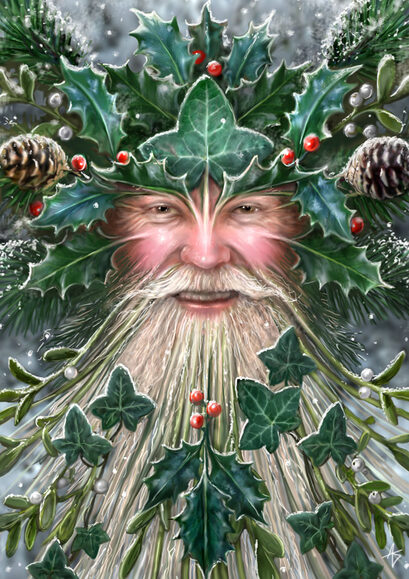
When we encounter depictions of the Holly King, he is often portrayed as proto-Santa Claus of sorts. A jolly, bearded fellow who may be wearing flowing robes and earthy, woodland-worthy hues. At times, he is also pictured with a group of eight stags – not unlike St. Nick and his famous team of reindeer.
His sparring partner, the Oak King is more apt to be pictured as the classic Green Man figure, though it is not unheard of for the Oak King to resemble an old-fashion style Kris Kringle as well.
Yule is also when some believe that the Goddess gives birth to the Sun and/or the Sun God. This birth materializes via the end of the darkening half of the year and the start of the lighter, sunnier half.
Midwinter is a time of opposites uniting. We acknowledge and honour both death and life, light and darkness. The past year and the present twelve months that lay beyond the threshold of January 1st.
Colours associated with Yule overlap, not surprisingly, a good deal with those that have long been linked with Christmastime.
In the colours of Yule, one is greeted with a palette of green, red, burgundy, white, yellow, gold and silver, as well as grey and black.
These represent such things as wintertime itself, snow and ice, the battle between the Holly and Oak Kings, the rebirth of the sun, and the start of the lighter half of the year.
Much as it is for all eight sabbats that comprise The Wheel of the Year, feasting is strongly connected to Yule.
Some Pagans and witches create a Yule meal that shares much in common with a classic Christmas Day feast.
Others may opt for foods that represent their ancestry, their homeland, their particular branch of Paganism/Wicca, or ingredients that pertain to kitchen witchery that they are currently engaged in.
Gathering with loved ones, coziness (not to mention hygge), sharing folklore stories, singing holiday songs, burning Yule logs (or making the edible version of this classic Midwinter tradition), looking ahead to the return of spring, leaving offerings (be it for house spirits, the fae, deities, ancestors, or others), setting up and working with Yule altars, all things candle related, and finding ways to stay warm and well during the winter months are amongst the many different activities that can be enacted at Yule.
I am an ardent believer that you need not break the bank to celebrate Yule – or any holiday, festival, or sabbat or that matter.
After two years of living in a pandemic-filled world – which has also been rocked by countless other tragic events events as well throughout that time – many of us have tightened our purse strings more than ever.
Splashing out for Yule, Christmas, Hanukkah, Kwanza, New Year’s, or any other wintertime celebration may not be feasible. (And that is 110% okay!)
Even if we are blessed to have more wiggle room in our budget, we are under no obligation to allocate for the holidays.
The following list of ways to celebrate the Yule season has been handpicked with affordability, spiritual meaning, and enjoyment alike in mind.
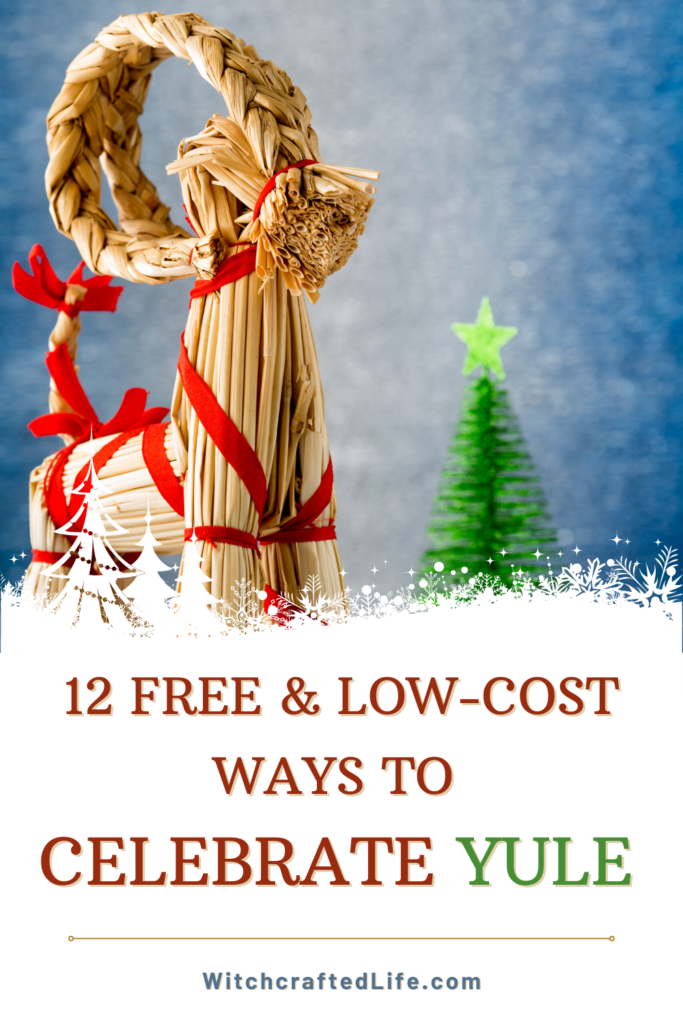
12 Free and Low-Cost Ways to Celebrate Yule and the Winter Holiday Season
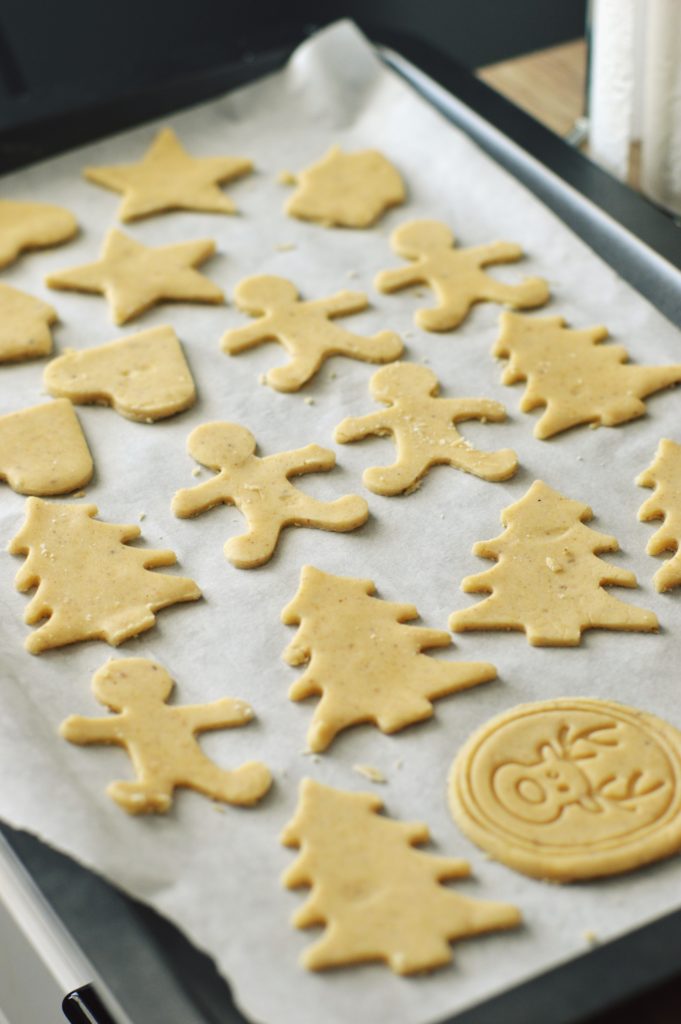
1. Collect and record your favourite Yule/holiday season recipes: In this day and age, when it often seems like fifteen versions of every recipe under the sun are at our beck and call 24/7 thanks to the internet, it can be easy to accidentally forget just how wonderful it is to collect + use treasured recipes of our own or those belonging to loved ones.
If you are not already doing so, consider using this Yule season as a great opportunity to start recording your favourite and most important holiday recipes (whether they are used as part of your kitchen witchery or not).
You can do so either in analog (handwritten) or digital form. Passionate writer + paper crafter alike that I am, I favour analog recipe record keeping, but readily see the ease and appeal of doing so on the commuter or a phone/tablet app, too.
If you do not currently have many of your family favourites on hand, contact loved ones to ask for recipes that you believe they may have and will be willing to share with you.
Slipping a simple note into your holiday season greeting cards that is tailored to each person you’re requesting recipes from, such as “Growing up, your gingerbread cookies were one of my favourite elements of the holidays. Would it please be possible for you to share the recipe for them with me?” is often all it takes to receive the recipe in question.
In my experience, relatives will frequently include other favourites, too, and/or pass along memories associated with their recipes or of the holiday season in general.
If you have loved ones who might appreciate a copy of this family holiday recipe book, consider making additional copies to give as future Yule/Hanukkah/Christmas/etc presents.
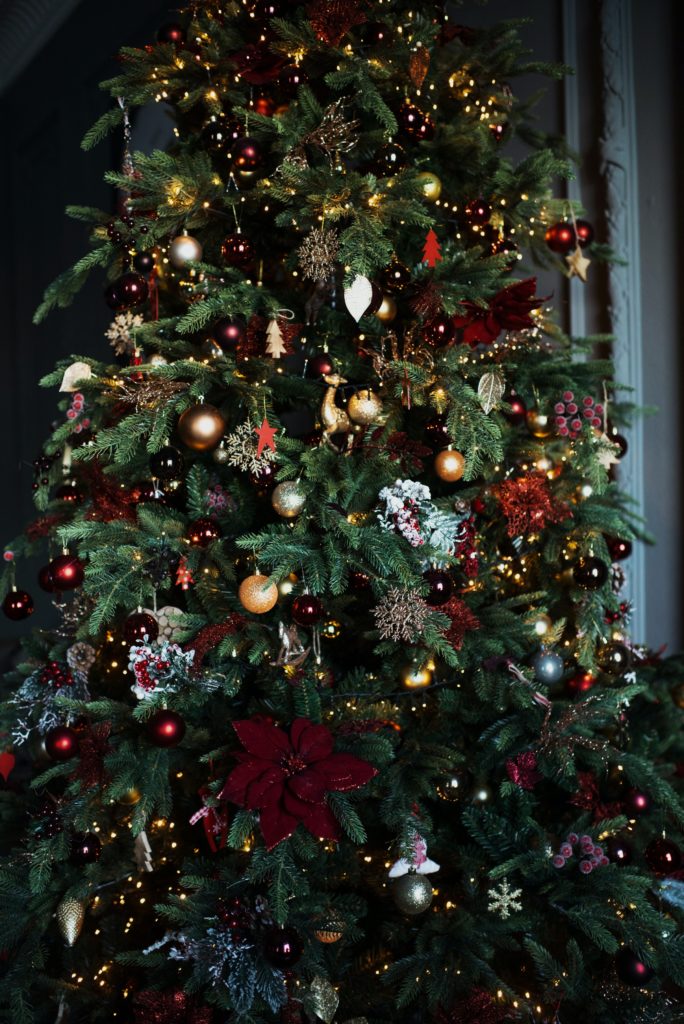
2. Decorate a Yule tree: Christmas trees are familiar to many people the world over and are a long-standing, beloved December tradition.
This year, why not decorate a Yule tree instead of, or in tandem with, a Christmas tree?
You can adorn your Yule tree however you please, though you may find it especially fitting to work with themes that relate directly to Yule itself.
This includes such things as candles (never have open flames on a tree; keep candles unlit or opt for LED-powered ones instead), suns, moons, stars, snowflakes, cinnamon sticks, dried citrus fruit, cranberries garlands, popcorn garlands, figures that represent the Oak and/or Holly King(s), poinsettias (always be careful when using real poinsettias, however, as they are very poisonous for cats, dogs, and many other animals), pinecones, Yule goat decorations, religious/spiritual symbols, ornaments with runes on them, crystals, and various animal ornaments such as deer, bears, and wintertime birds.
You could also place a miniature Yule tree on your altar or even turn a larger tree into a seasonal altar of its own – after all, there is nothing that says an altar has to be on a flat surface.
3. Go Wassailing at Yule: Wassailing is the precursor to the act of Christmas carolling, with roots stretching back to pre-Christmas times when some early Europen people would walk through their communities and fields around Midwinter singing, chanting, and hollering as a means to chase away any unwanted spirits that might be lurking there.
Over time, wassailing and the later act of carolling both came to involve going door-to-door singing festive songs.
Traditionally, wassailers and carolers would often be invited in to peoples’ homes or otherwise handed a hot beverage to help keep them warm and buoy their energy levels during a busy night of singing around the town or village.
If doing so under these ongoing pandemic times is something you and your fellow singers feel comfortable with, consider gathering a group of friends, coworkers, relatives, coven mates, etc together to go wassailing around a safe, well-lit part of your own town.
Agree upon a selection of anywhere from around forteen to twenty songs beforehand that you will sing during your wassailing session.
For a multitude of reasons, you may wish to stick with nonsecular holiday songs. However, if everyone involved is genuinely comfortable with it, religious entries are certainly okay as well.
You could also consider picking a selection of holiday/Christmas songs that are now in the public domain (and thus free of possible copywrite issues) and altering the words to create more Pagan/witchy/Yule-focused lyrics instead.
And the especially musically or writerly inclined can also create their own original Yuletide songs as well and share those with the group.
I would suggest a dry run or two at home in the days before your designated night of wassailing, to get a sense of how long your list of songs takes to complete, how everyone feels about it, and to make sure your voices will not run hoarse by the end.
Come the big night, go out early enough that most people are still awake (say, between 6 and 8 pm, for example).
Stroll through the neighbourhood close to homes (it is up to you and your group as to if you are comfortable knocking on doors, especially if you are not looking to receive anything in return for your singing) and let your festive notes dot the chilly winter air like musical snowflakes.
And, naturally, you and your group may want to cap off your evening of lyrical merriment by returning home to a warm mug of the drink (also called) wassail, which was traditionally given to wassailers in the UK.
The wonderful cooking blog Yummy Healthy Easy has an alcohol-free wassail recipe that looks thoroughly delicious.

4. Work with stones and crystals for Yule: Many of us work with stones and crystals the whole year through. I am convinced, however, that crystals are sometimes reached for more often during the sunny months.
This winter, celebrate Yule all the more by integrating crystals that are well-suited to the snowy season into your spiritual/magickal practices.
The following is a selection of crystals and stones that are a good fit for Yule:
-Morganite
-Garnet
-Ruby (small, raw ruby pieces and chips are often considerably easier on the wallet than their polished jewelry industry peers)
-Red tiger eye
-Bloodstone
-Dragonstone
-Citrine
-Goldstone (including green goldstone)
-Pyrite
-Emerald
-Aventurine
-Malachite
-Galena
-Snowflake obsidian
-Black onyx
-Obsidian
-Diamond
-Selenite
-White howlite
-Moonstone
-White chalcedony
-Snow quartz
-White calcite
-Clear quartz
Some ways of working with crystals – be they the ones listed above or otherwise – during the Winter Solstice include placing crystals and stones around your Yule altar, peppering them throughout your festive décor, wearing them or carrying them (in a pocket or in a small pouch around your neck, for example) on you during the holidays, creating a Yule crystal grid, charging your crystals in the light of the Yule night moon, presenting gifts of your favourite Yule crystals and stones to fellow crystal fans, working with Yule crystals in some of your spells, and meditating with your Yule crystals during the holiday season.
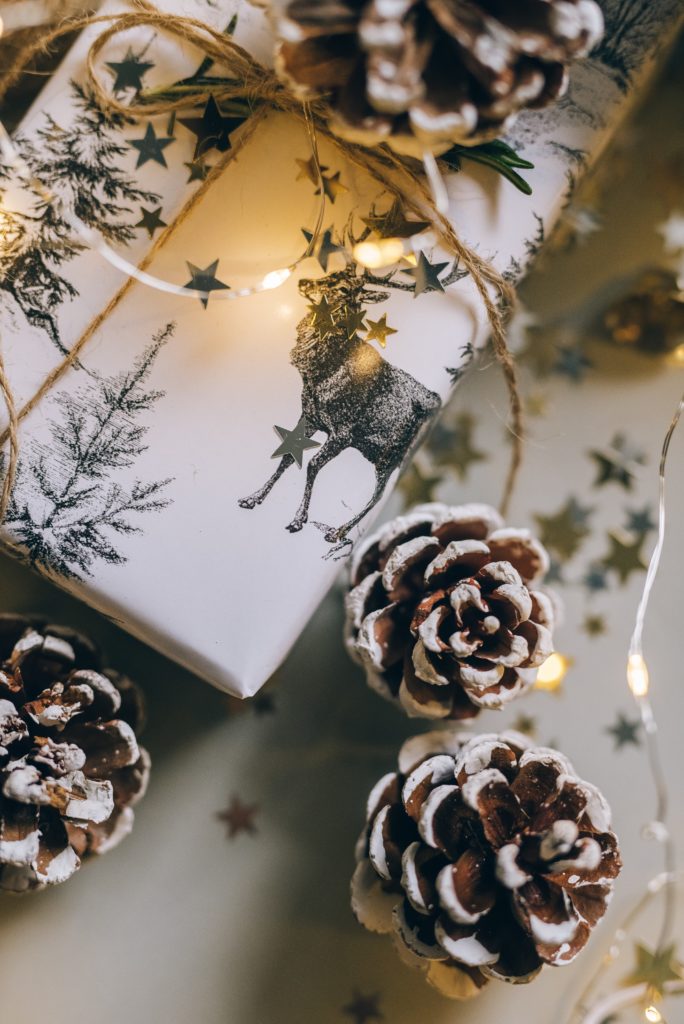
5. Create your own Yule wrapping paper, gift tags, and/or greeting cards: While it is possible to buy Yule cards from various sources, including Etsy, if you are so inclined, it can be both wonderfully fun and especially meaningful to create your own Yule gift wrap and cards.
I would suggest starting with a versatile material such as brown mailing paper, butcher’s paper, or rolls of blank newsprint for the wrapping paper.
Stamp, hand draw, or paint desired Yule-themed imagery, such as candles, pentacles, pine boughs, holly leaves and berries, poinsettias, suns and moons, Yule logs, yule goats, or snowflakes. Allow images to dry completely before wrapping gifts.
Carry the same types of themes over to things like gift tags and greeting cards as well. In these two cases, you may have the abilitiy to computer generate and print out Yule sentiments and/or images as well, if that option appeals to you.
Consider using an extra special product or two, such as handmade paper, mulberry paper, metallic cardstock, glitter cardstock, velvet ribbon, festively hued baker’s twine, or winter/Yule themed charms to give your handmade paper crafts even more festive season loveliness.
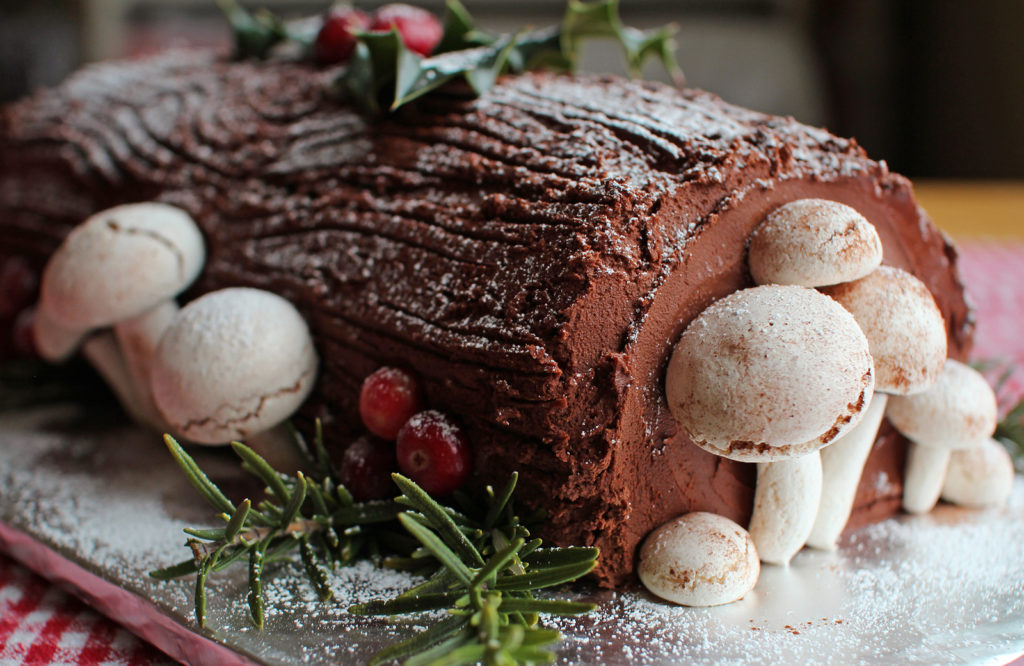
6. Incorporate a Yule log as part of your Midwinter celebration: If you are fortunate to have a wood-burning fireplace, you can likely opt for the real deal.
If that isn’t the case – or in addition to an actual Yule log – consider making or purchasing a Yule log candle holder.
Here is a handy tutorial on How to Make a Yule Log Candle Holder.
If you are more in the mood for some festive sweet treats, then you may want to give Yule Log Cookies, Yule Log Cupcakes, Ice Cream Yule Log, or a classic Yule Log Cake – also known as a Bûche de Noël – a spin.
For those, like me, who cannot have or do not wish to eat gluten for any reason, here is a scrumptious looking Gluten Free Yule Log Cake recipe.
And, if like me as well, you also need to eat Low FODMAP, allow me to present this stellar Low FODMAP Yule Log Cake.
Those who partake in the Paleo diet are apt to swoon up a storm over this beautiful Paleo Yule Log Cake.
For low carb eaters who partake in dessert, this Keto Yule Log Cake is likely to be a big hit.
For those who do not, or cannot, eat animal products, this Vegan Yule Log Cake looks terrific.
And this recipe for Gluten-Free Vegan Yule Log Cake is just the ticket if animal products and gluten are both no-goes in your kitchen.
7. Reflect on what you are grateful for this year: It is safe to say that 2021 has not been a particularly easy or low stress year for a lot of folks (myself included).
We would be here until at least next Yule if I listed all of the global events that made this such a challenging year.
Instead of doing that, let’s take a few heartfelt, peaceful minutes this festive season to stop and give thanks for those positives, whatever their size or scope, that we were fortunate to encounter in 2021.
Find the good that shines like starlight in dark times, count blessings both known and unknown, and make a point of telling those you appreciate just how truly grateful you are for their presence in your life.

8. Get your home ready for the coming year: Either before, during, or just after the Yule season, if possible, take some time to assess your home and what you could do here and now to spruce it up, declutter, or otherwise improve your living space.
Yule, situated as it is on the precipice of a fresh new year is a superb time to tackle organizational, home repair, cleaning, and, weather permitting, yard work jobs.
Give yourself and, if applicable, those who live with you the gift of a cleaner, more organized home as you head into 2022.
I have been doing this for many years now and find that my autumn/early winter cleaning is generally more important (and larger) than my spring one, as I am especially eager to get our nest in the nicest shape possible as we hunker down inside for the new few snow covered months.
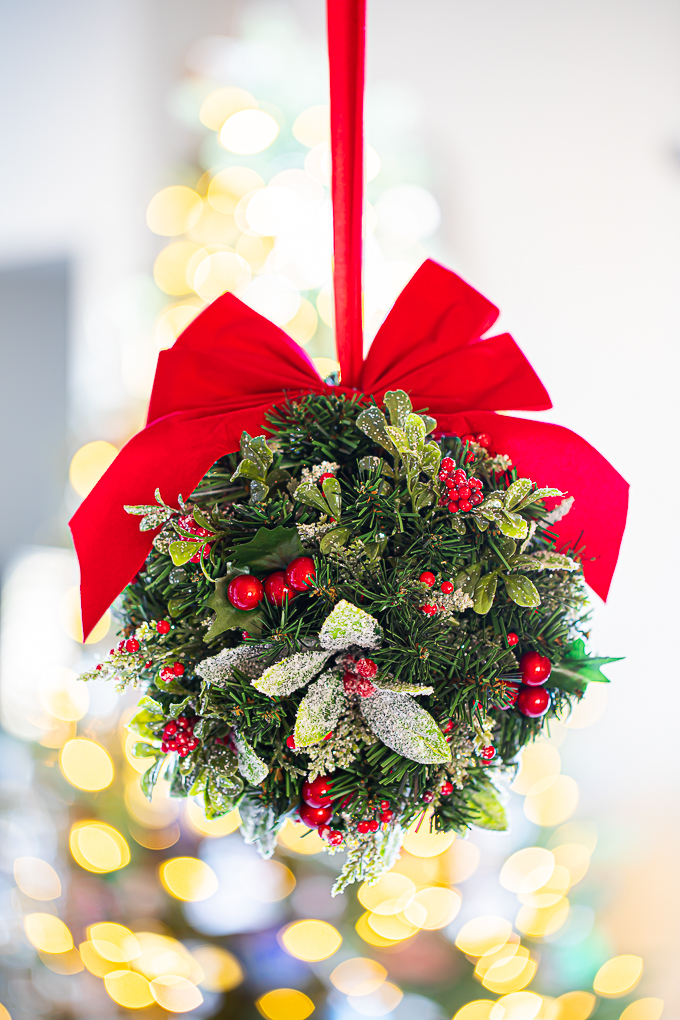
9. Make a Yule (or Christmas) kissing ball: While many of us are familiar with holiday season wreaths and springs of mistletoe suspended from ceilings and doorways, the classic Yule or Christmas kissing ball is less well known.
This centuries old tradition involves making a ball shaped decoration from wintertime greenery (real or artificial) and hanging it up in your home or workplace as a symbol of friendship, peace, respect, love, and blessings to all who encounter it.
You can jazz up your Yule kissing ball with other accoutrements, such as ribbons, tiny ornaments, pinecones, nuts in their shells, dried fruit slices, wintertime berries, cinnamon sticks, whole star anises, or candles (keep candles unlit for safety’s sake or use LED candles if you wish to light them).
Check out this great post on the blog A Pumpkin and a Princess for details on how to make your own DIY Christmas Kissing Ball.
And if making a kissing ball from scratch isn’t in the cards, but you are keen to decorate with one this year, check out Christmas tree farms and lots, nurseries, and florist shops for pre-made versions. Or, skip the real greenery and opt for a lovely little ornament, such as this gorgeous Mistletoe Kissing Ball Ornament by Ganz, instead.
10. Do as little work as possible: Tradition holds in some European cultures (particularly amongst the older Germanic and Icelandic peoples) that one is to undertake as little work as possible during Yule.
Instead, the emphasis is to be on family/friends, celebrating the holiday, and the meanings + messages that Yule holds for each of us personally.
If you are a in position to take things easy and not work (be it for a few hours, a day, or longer), give yourself that gift this festive season.
Consider taking a social media or full-on internet break, only responding to the most urgent or important of phone calls and text messages, and unwinding alongside the serenity of winter.
If you cannot step away from your work entirely, is it possible to carve out a couple of quiet hours one day to engage in peaceful activities that bring tranquility and happiness to your heart?
This can be something as low-key as taking a quiet nature walk through a snowy wood, curling up with a warm blanket and watching your favourite holiday season films, or ordering in dinner to spare yourself the work of cooking that evening.

11. Put together a Yule season playlist: Use your favourite music app or create a YouTube playlist of videos featuring songs that hold particular meaning and/or enjoyment for you during the holiday season.
Or write out your selection and use analog forms of music such as records, cassette tapes, and/or CDs to put together a list that you can assemble and play througout Yuletide.
You could opt for all instrumental and/or soft music or chanting songs. This can be especially lovely to listen to while meditating, engaging in ritual or spell work, as a way to help you unwind during the hectic holiday season, or even as a sleep aid when it is time for bed.
Revisit your festive song selection each December, adding or subtracting from it as desired so that you always have a meaningful Yuletide playlist that you adore at the ready.
12. Give freely in the ways that you can this Yule season: So often we associate the words “giving” and “holiday season” with presents that deliver a one-two punch to our bank accounts.
I am not opposed to giving gifts that you pay for, but I also believe that there is a good deal that some of us can give that costs little to nothing in terms of money.
For example, you can offer someone with young kids two evenings (or weekends, if you’re up for it!) of babysitting. You can make and take homemade treats (preserves, jams, breads, muffins, cookies, dried soup mixes, spice blends, pickles, salsas, etc) to neighbours and loved ones – always checking for food allergies, intolerances, dietary requirements and so forth first.
Some other ideas include:
-Walking someone’s dog for a few days
-Offering to housesit for a long weekend
-Teaching someone the basics of a skill you have mastered
-Hosting a clothing and/or home goods swap party
-Doing a holiday baking exchange with a few people
-Volunteering to foster a shelter/rescue pet
-Inquiring at your local community centre or place of worship if there are any jobs they need done during the winter months
-Shovelling snow for your neighbours (especially if they have medical challenges, are elderly, or otherwise unable to do so themselves)
-Making a quilt or blanket to donate to a local homeless shelter or mission
-Creating wintertime birdseed bells for a gardening or birding enthusiast in your life
-Offering to help someone declutter or do simple DIY jobs around their house
-Scanning and digitalizing a loved one’s printed photos
Or simply ask someone you care about what you could do for them that wouldn’t cost much (or anything), but would be a tremendous help.
Trust me, this gesture often means the world to people and can be every bit as helpful and appreciated – if not more so – than the majority of things you could purchase online or in a shop.
And while you’re at it, strive to get children, grandkids, or other little ones in your life involved with the concept of giving gifts that go beyond store-bought items and instead focus more on their own time and abilities.
I wish you the merriest, the merriest, the merriest Yule cheer!
Like many of us, I have quite the mixed bag of December and early January memories. Some great, some awful, some funny, some sad, some joyful, and plenty that are, well, simply what they are! 😄
Along with a fair number – but certainly not all – of my fellow witches and Pagans, I opt to celebrate both Yule and, in a secular sense, Christmas.
Not unlike Samhain and Halloween, I see them as being akin to two sides of the same (icy cold) coin.
One is intimately woven into the fabric of my spiritual path, the other is laced with a lifetime of memories, traditions, cultural references, treasured activities, festive recipes, and delightful holiday season songs.
Okay, come to think of it, my Yule celebration includes all of those things at this point, too. 😊
However, as a solitary witch, I observe Yule solo, whereas Christmas is shared with my (non-Pagan/witchy) husband and other loved ones.
When possible, I strive to celebrate Yule for at least twelve days. Finding meaningful ways to honour, celebrate, and rejoice in the magick and ancient energy of this potent chapter of the year.
Some traditions, particularly amongst the Norse/Heathens, have long viewed the twelve days of Yule as being mini representations for the twelve months of the year.
I adore this concept and find that it resonates deeply with my own Wheel of The Year focused path.
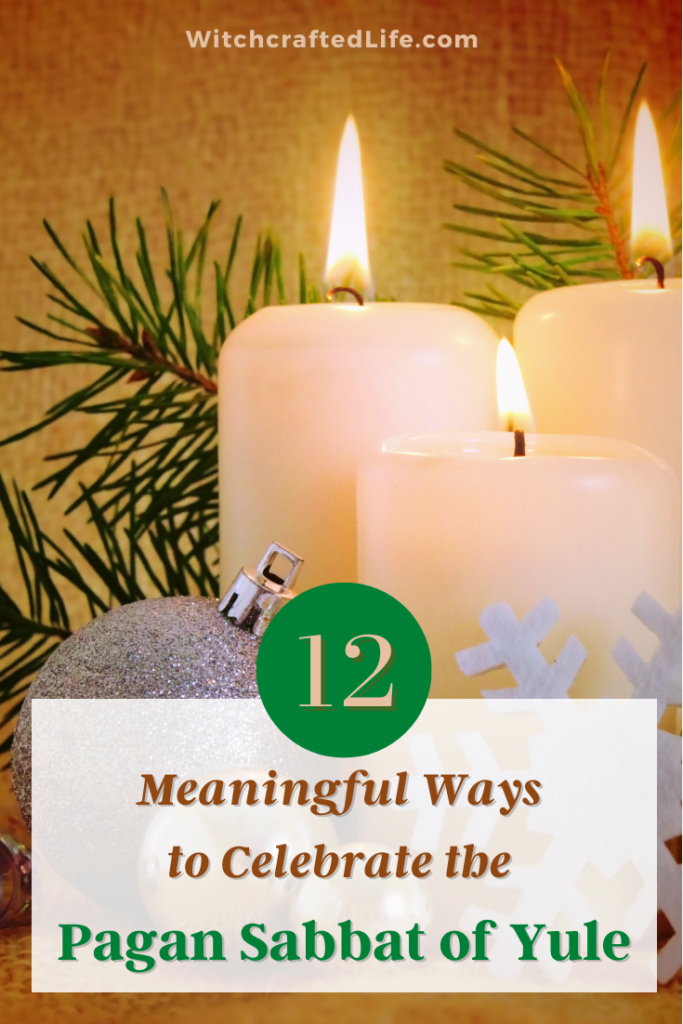
It was the concept of the twelve days/nights of Yule along with the classic twelve days of Christmas that determined the number of entries included in this very blog post.
I know that this time of the year is not everyone’s cup of wassail. I respect this fact and wholeheartedly understand how and why December can be a highly difficult month for some people.
Just as I do the fact that not everyone wants to be – or can be – as jolly as Santa come the dark, challenging days of December.
However the year’s last month unfolds for you and whatever you choose to celebrate (or not), know that it is my heartfelt wish that you have a safe, meaningful, and, hopefully, positive December.
May the ideas in this post help to inspire your own Yule and winter holiday season happenings, and may you have the very merriest of Yuletide seasons, dear friends! ❤️
Which of the twelve budget-friendly Yule ideas above appeals to you the most? What are some of your favourite ways to celebrate the Winter Solstice? 🕯️🎄🕯️
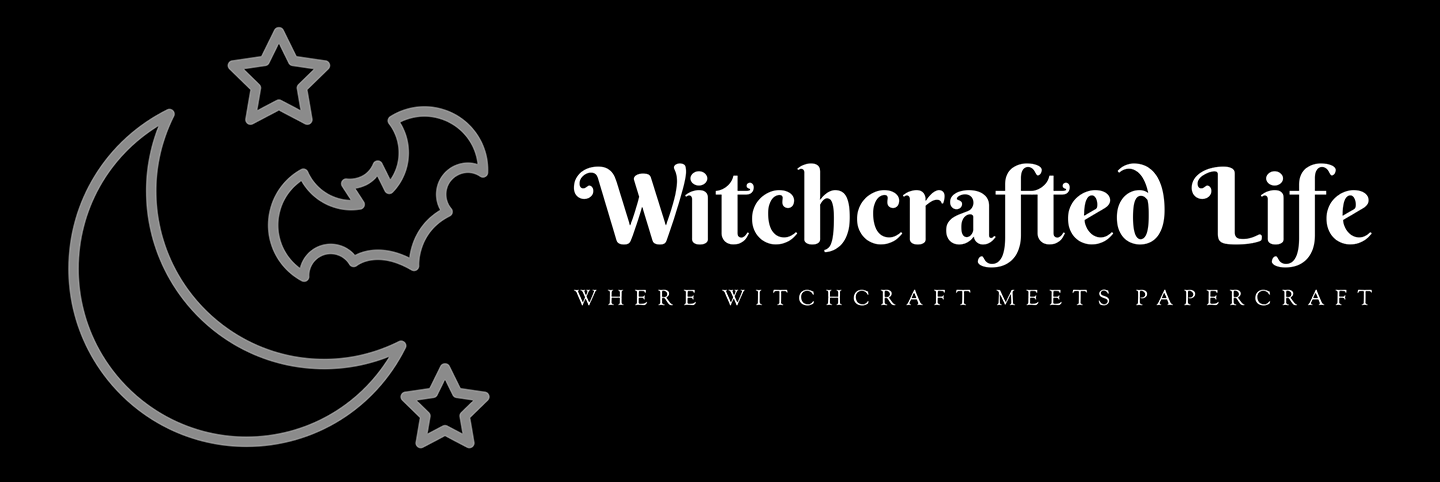
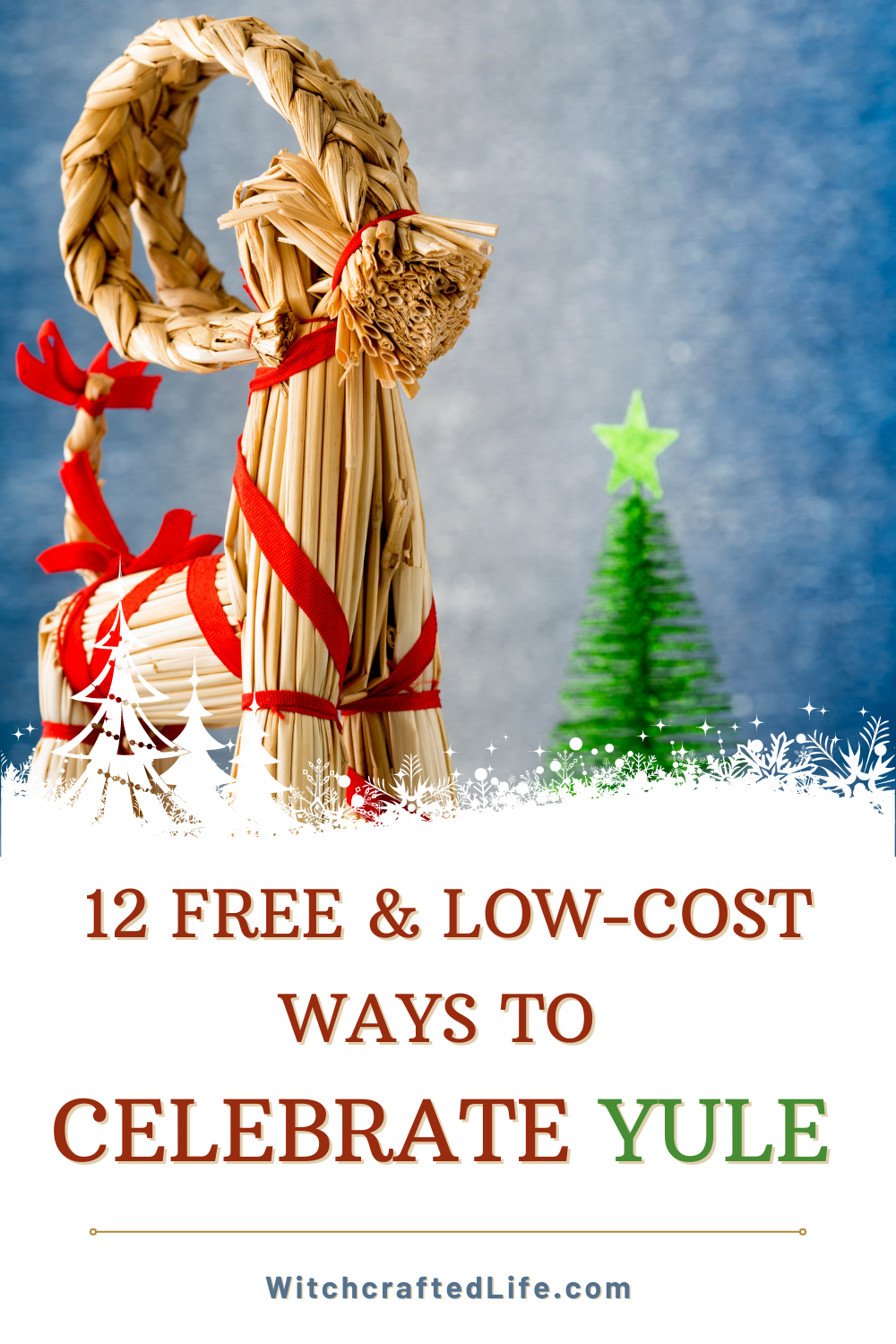
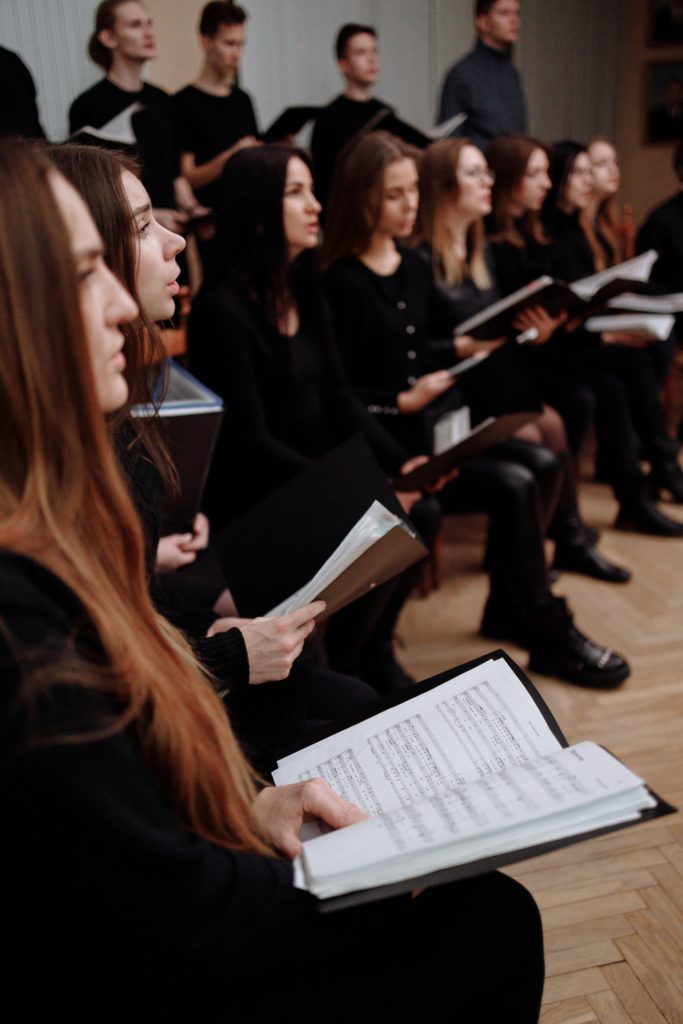


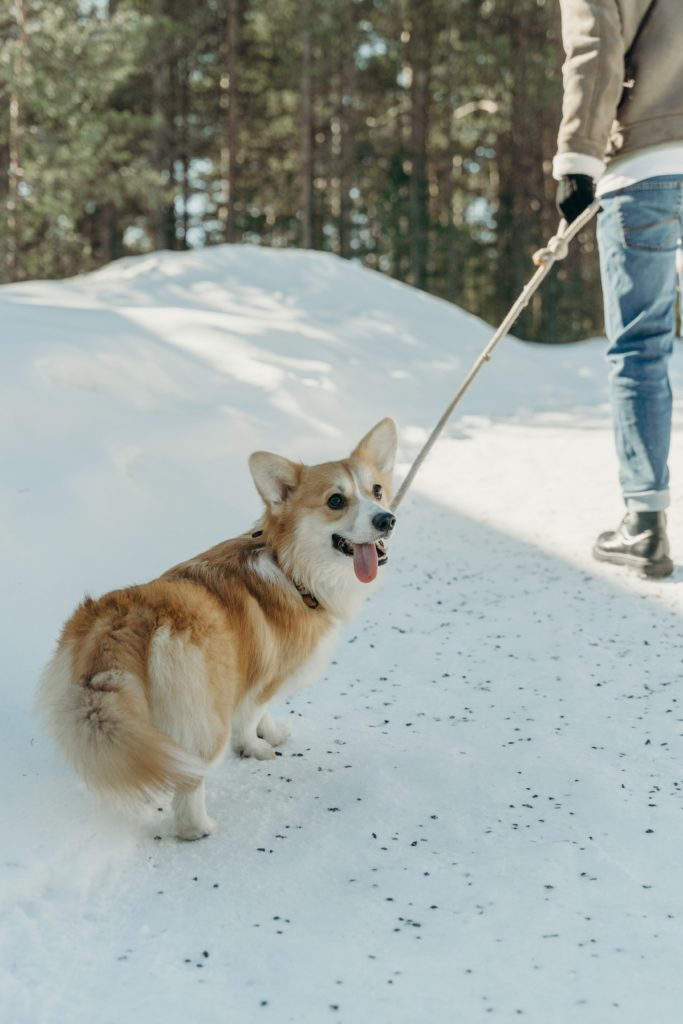

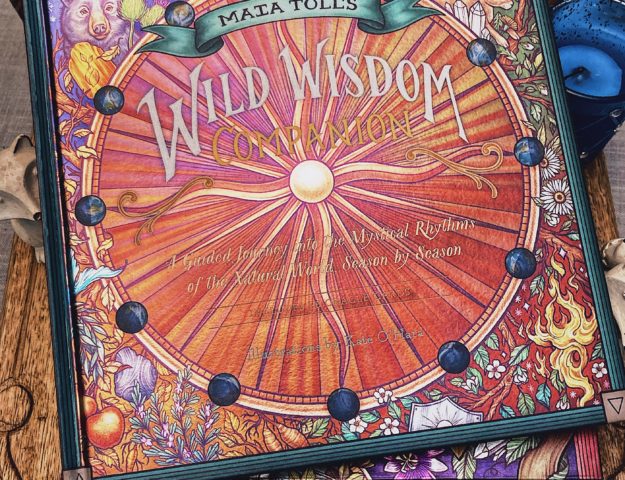
Happy Yule! I may share a Yule poem on my blog closer to the day. One of my fav songs with it is The Christmas Song “ Yuletide carols being sung by a choir..” love it.
This was an informative and delight filled post as always! I love gluten free Yule logs and we have one every year!
Oh and here it’s definitely midwinter- I’ve always thot the calendar was ridiculous on that regard because we are usually three months of snow ( tho this year was an exception and we only began snow a couple weeks ago!) but usually it’s definitely midwinter though usually we still have snow till end of March for sure but I love the year’s when February brings spring like temps!:)
I wish you the happiest of memories at at least one point this season.
Thank you very much for your terrific comment, dear Kmarie. How delightful that a GF yule log cake is a beloved tradition at your house.
Agreed. While there are parts of the world that fall generally within the current seasonal bounds, a lot of others start or end at times that do not jive with what the calendar says. The ancients were usually far more attuned with the seasons and shifts in weather, which is why many of them consider the third week of December midwinter and, likewise, the third week of June as midsummer.
Likewise, too, on the snow front. Rare is the year that we don’t have snow until well into March, if not April (my mom’s b-day is April 2nd and we’re watch snow tumble down on it many times over the years).
We’ve been getting enough snow to duplicate the North Pole, if needed, as of late and are starting to experience our extremely cold temps earlier than usual this time around.
Typically they hit us in January and spill over into February, but this time around, they’ve kicked off before Christmas Day.
The optimist in me is hoping that means we’ll be shared ultra-cold temps in Jan and Feb and that we might even get treated to an earlier spring. Likely wishful thinking, but you just never know these days with climate change continually impacting Mother Nature’s usual rhythms.
Thank you again very much, sweet soul. Not only for your lovely comment and the meaningful wishes it houses, but also for each and every blog comment you blessed my site with throughout 2021.
Warmest hugs & the very merriest of New Year’s countdown wishes,
🖤 Autumn
Interesting and informative article, as always! Those cookies look wonderful!
Thank you very much, Donna. I sincerely appreciate your positive feedback regarding this festive post and concur completely regarding those scrumptious holiday season cookies.
I hope that you + your loved ones had a fantastic Christmas and that you are able to keep savouring the festive magic of this time of the year straight on into January.
🖤 Autumn
Great post Autumn! I love the history of Yule and the traditions surrounding it and how many of them have been incorporated into what we now relate to as a Christian holiday. Great ideas on free or lost cost ways to celebrate the holiday. I love the idea of saving old recipes. I’m not much of a cook but I had several family members who were and I still have many of their recipes in a book. They are great and treasured memories!
Thank you deeply, sweet Celeste. I’m touched to know that the suggestion of gathering up and documenting treasured family recipes in one spot struck a chord with you.
Before the arson house fire that we experience in 2016, I had several notebooks (started back in childhood around the age of 8 or 9 years old) of my own recipes that I’d invented or adapted over the years, as well as both notebooks and some scrapbook pages documenting beloved family recipes.
It was a blow indeed to lose all of that information in one swift fell, but thankfully I have a lot of my own recipes in my head still and have been able to obtain some cherished family ones again in the years since that fateful event. (Perhaps I’ll scrap some of them again as time goes on.)
Save for being colder than usual for our area at this point in the year, all has been radiantly lovely (literally in some cases, as we’ve sunshine here two or three times recently) around these parts during the festive season and I hope the same is ringing true on your end as well, my friend.
🖤 Autumn
What a wonderful and informative post, Autumn. I greatly admire how thoroughly researched your post are, and I’m learning things I didn’t know which each and every one of them. Loving your low-cost ideas too. Plus, you’ve given me cravings for cookies and a hefty slice of yule log now 🙂 xxx
Thank you abundantly, sweet Ann. What a supportive, meaningful comment (compliment!).
It warms my heart to connect with you (and your awesome blog) again during the holiday season – just as it does to do so the whole year through.
Thank you very much as well for every kind, lovely, uplifting comment you blessed my blog with throughout 2021. They are appreciated beyond measure – as is the beautiful gift of your longtime friendship.
🖤 Autumn
What lovely ideas, Autumn. Although we walk separate paths, I do love acknowledging Yule also. Years ago I constructed a Yule log similar to the one in the tutorial that you so graciously provided. It was lost in our move to this current home….so that may be my next project.
I love the idea of incorporating so many of the items found in our forest. And, we are blessed to be surrounded by greenery and Holly bushes. In fact, I counted 11 that are springing up on the edge of our property.
Thank you for such an informative post.
Thank you deeply, dearest Debi. So much of what helps to make life interesting and multi-faceted is that we do not all march to the beat of the same drum – be it when it comes to our faith/spirituality, fashion, tastes in music and movies, favourite time periods or countless other things.
The holly bushes around your property sounds magnificently lovely. We do not have any at our current house/yard, but are fortunate that a bevy of hearty evergreens and enchantingly pretty birch trees call our (literal) backyard home. Both of which are timelessly festive in their own right, too.
Do you have any ivy? We’ve lived (some) past houses that did, but alas, none here either. I absolutely adore ivy and daydream of living in a house one day where lush ivy snakes up the walls.
Thank you again very much, my treasured friend. You are often in my thoughts and heart during this enchantingly festive time of the year and I hope that you + your loved ones are experiencing a tranquil, abundantly joyful Christmas season.
Warm hugs from uber chilly BC (it was -28C/-18.4F when we got up today),
🖤 Autumn
Happy Yule, dear Autumn! As you know, I worked in a year-round Christmas store, but not being a Christian myself, I embraced the season and all of its historical aspects and learned a ton about the traditions. We sold kissing balls and Lords of Misrule, and holly and ivy were important parts of our decorations.
This always feels like the turn of the year for me, too. I also like to fully nestify my home for the coming cold. Not to mention, the days will start getting shorter – the hope of spring ahead.
All the best to you.
Thank you deeply, dearest Sheila, on every front. I so adore hearing about when you worked at that Christmas store. I suspect it would have been a job I adored and gotten a lot out of the experience from as well.
It’s terrific that you sold a wide range of festive season offerings there, including Yuleballs. Just as it is that you were/are keen to continually learn more about traditional aspects of the Yule season (same here all the way).
I hope that you and L have been experiencing a peaceful, immensely happy holiday season and that it soon tumbles into a great 2022 (complete with an early spring) for both of you.
Oodles of hugs & festive wishes,
🖤 Autumn
I always learn so much from visiting your blog! I will be celebrating low-key this year as well. No decorating other than a table-top ceramic tree my father made for us when we were first married. We don’t exchange gifts anymore because if we need something we buy it, so we don’t break the bank at all. We’ve toned down Christmas for a few years now and we actually like the quiet calm and peace with the drama being elsewhere for the holiday! Happy Yule to you and yours!
That is a wonderfully supportive and meaningful comment, Carol. Thank you deeply.
I hear you big time. My family has scaled back over years and we never put any pressure or expectations on one another to give gifts at Christmas (or any other point in the year, for that matter). Some years we’ve done a Secret Santa amongst each other, which automatically helps to lessen the financial impact of the holidays by reducing the number of gifts one needs to buy or make to just those for a single individual.
Gift-giving and receiving can certainly be a marvellous aspect of December, but there are plenty of others, too, and one need not spend a cent (let alone break the bank) to have a meaningful, memorable and very happy holiday season.
Warmest festive wishes in turn to you and yours as well.
🖤 Autumn
Stunning post and informative…hugs to you at Christmas. x
You are tremendously kind, sweet Annie. Thank you very much on both fronts.
I hope that you and your loved ones are experiencing a relaxing, joy-filled festive season. (I’m happy to report that we are doing just that on this end – even with the bone-chilling temps that came calling especially early here this year.)
🖤 Autumn
Sending happiest Yuletide wishes Autumn,lots of new ideas for inexpensive and handmade makes,my tree is dressed with decorated pine cones collected in the Spring and dried for several months, crochet snowflakes and a few vintage ornaments I was lucky enough to get about 25 years ago. At this time especially, family traditions are more important to my family. Thank you for another great post.
Thank you sweetly, lovely Meg. I adored hearing about the treasured seasonal decor that you put out each year.
Thus far, in the five years since the arson house fire that we experienced in October 2016, the majority of my/our seasonal decor focus has been on Halloween. Next year, however, if at all possible, I would like to work on growing our Yule + Christmas season decor a bit more – including by adding an artificial tree to our lives again.
Time shall tell, but as I hope/plan to make some festive decor pieces before then, that alone should help us to have more to put out in future years.
Big thanks again & the very warmest of hugs coming your way.
🖤 Autumn
Thank you for all the ideas and the interesting history of yuletide. I had no idea. Love reading your posts, but sometimes they have to wait until time allows xx
Thank you deeply, lovely Hilary. I truly appreciate not only your supportive words here but that you set aside some time to read my posts in full. That is such an uplifting and encouraging thing to be told.
Having run various websites of my own for over 17 years now, many of which involved writing many tens of thousands of words per month, it was only natural that I extended my passion for writing to my current blog. I get that not everyone has the time for longer blog posts though and do try to keep some of my entries below 2,500 words for that very reason.
With others though, I happily let the word count run free, so to speak, and as there are few topics I can joyfully talk at length about than The Wheel of the Year, it’s a safe bet to say that many of my posts on this subject will be many paragraphs long. 🥰
Many heartfelt thanks again, sweet lady. I hope that you and your family are savouring a relaxing, beautiful and very happy holiday season.
🖤 Autumn
I don’t know why I see this now, but enjoyed reading it very much. I might have been too busy in December to read it then.
Yule sounds much like a Scandinavian tradition, Yule meaning “jul” in Danish, in fact I’ve heard the English language have 300 Danish words back from the Vikings. E.g. yule tree is juletræ in DK. And also pronounced much the same.
The Danes have invented hygge due to the long cold and dark winter. And hygge is just lots of candles, gathering with loved ones, eating, perhaps gaming and listening to nice music, definately talking and laughing a lot. Hygge is more a feeling than being expensive, so it is easy to adapt for everyone.
And now we’ve gained 1,5 hours more daylight, yipeee! 🙂
Have a lovely day, dear Autumn. ♥
Thank you deeply, my very dear friend.
Zero worries in the slightest. December is so often a jam-packed month and it’s likely safe to say that few amongst us spend as much time online during the year’s final month as we’re apt to for much of the rest of the calendar.
I too have read similar things regarding how quite a few English words have Danish origins. I do not speak or claim to understand Danish, but at times when I have listed to it being spoken (for example, in movies) I have instantly picked up on certain linguistic similarities between the two languages.
I find the subject of linguistics as a whole to be wildly fascinating and have spent many a happy hour deep diving the subject on Wikipedia, other sites, and through no shortage of YouTube videos. (If you are a fan of the latter, I cannot recommend the a channel called NativLang highly enough.)
How right you are regarding hygge and the fact that it absolutely does not need to break the bank – or even, in plenty of case, cost a penny.
To me, one of hygge’s greatest appeals and most enduring qualities is the sense of days long past, before much of the technology of today’s world was present in the lives our ancestors and people took immense joy in the simple pleasures of the seasons, each other’s company, and finding ways to keep their spirits up no matter how chilly the weather became outside their door.
I am a huge proponent of simple, earnest living with an eye to tradition and love embracing hygge the whole year through.
Many thanks again, sweet Sanne. I hope that your winter holiday season was a terrific one and that 2022 is off to a positive start on your end.
Huge hugs,
🖤 Autumn